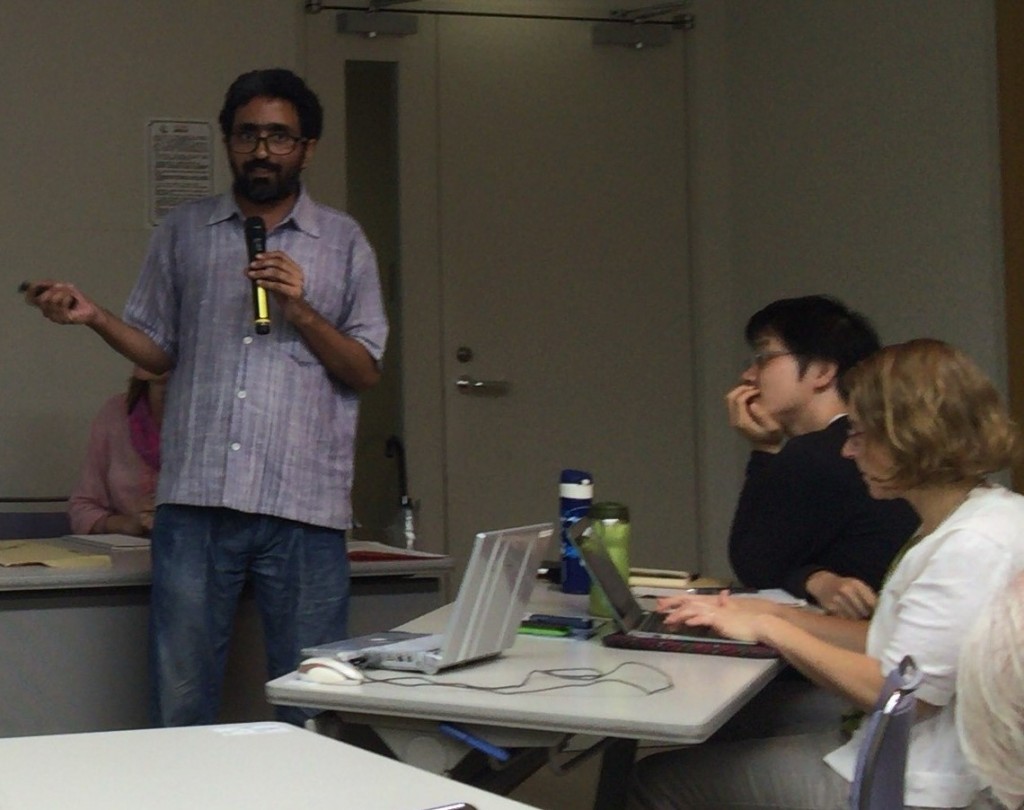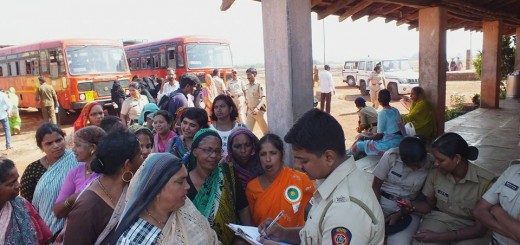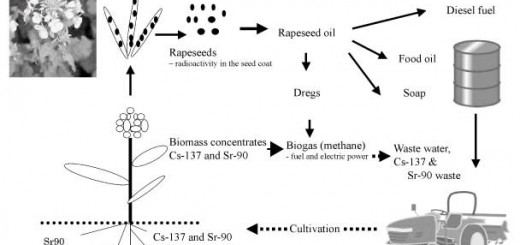by Kumar Sundaram, Coalition for Nuclear Disarmament and Peace, New Delhi, India

Kumar Sundaram speaks at CNIC’s open research seminar on August 16
This year-end, the Indian Prime Minister will visit Tokyo and there are speculations that the India-Japan nuclear agreement will be finalised during his trip. Last year, the Japanese PM visited New Delhi, and the two countries signed a Memorandum-of-Understanding, declaring an in-principle consummation of the deal while the details will be worked out for final agreement. Since then, the two governments, and the media in both countries, have been telling different stories to their people, maintaining a complete secrecy about the actual terms of the agreement. While the Japanese PM asserted in parliament that India has agreed to include a no-test pledge as part of the bilateral agreement, the Indian side has claimed that its insistence for keeping the nuclear test option open has been accommodated.
While this agreement will unleash a host of issues if the supply of nuclear technology to India starts, in terms of the attendant problems of an unsafe, uneconomic and undemocratic nuclear expansion in India, it is important to recognize that from international perspective, this agreement is part of the larger developments in the past decade which have reversed the gains of the global non-proliferation order.
The global nuclear architecture is facing crisis
The international nuclear order, built around the Nuclear Non-Proliferation Treaty (NPT), is under the most serious strain since its founding in late 1968. All the three major central tenets of this near-universal treaty are facing terminal crisis. Firstly, the NPT Treaty said that non-nuclear weapons will ensure non-proliferation of nuclear weapons. Today, ironically more than 30 countries have the wherewithal and know-how for making nuclear weapons, precisely because of the NPT. Secondly, the NPT said that the member states would have an ‘inalienable right’ to the so called peaceful nuclear technology. This pillar of the grand bargain is being used by all potential proliferators to amass advanced nuclear capabilities, and reach a threshold where weaponisation remains only a matter of political decision. Despite the undeniable link that has emerged in the past five decades between the civilian and military uses of nuclear technology, the NPT system has not been able to rectify this central contradiction because the nuclear weapons states have not fulfilled the promise to negotiate global disarmament, which is the third important pillar of this treaty. Not only do the NPT weapons states continue to hold nuclear weapons central to their national security, they are investing heavily in modernisation of their nuclear arsenals. The most basic step in this direction – a ban on further nuclear tests, a promise on which the NPT was extended indefinitely in 1995 – has also remained elusive.
Nothing could be more telling about the glaring crisis in the regime and the urgent challenge that it represents than the failure of the NPT Review Conference last year. The 2015 RevCon failed to produce a final document. The primary reason was the failure to implement the resolution of the previous RevCon which called for a zone free of weapons of mass destruction in the Middle-East. The insistence of the non-aligned countries to hold the ‘inalienable right’ clause non-negotiable and the failure on behalf of the weapons states to move in the direction of abolition of weapons, even notionally, underpinned this crisis.
What would have been the imperatives in such a situation? Nothing short of an overhaul of the global order can prevent the NPT regime’s destruction now, and especially countries like India and Japan, which claim to have progressive foreign policies born out of their experiences of colonial control and nuclear bombing, could play a more positive role here. The current situation demands three sets of remedies. The first is adoption of more honest, credible and consistent efforts towards the abolition of nuclear weapons. This would provide the regime with the required confidence and moral force to convince the member states to revisit the promise of nuclear supplies for ‘peaceful’ purposes and thus plug the second hole in the NPT system. Thirdly, the experience of the Fukushima disaster should have led to joint international mechanisms to put in place more stringent and transparent safety norms for the nuclear power industry and an eventual shift away from nuclear energy.
Japan and India could play an important role for all the three aforesaid imperatives. As the victim of both nuclear bombing and a nuclear energy accident, Japan could lead the world towards a nuclear-free future, highlighting the inextricable link between the two forms of this technology and introducing progressive revisions in the system for the same.
However, the developments of recent years have been exactly the opposite and extremely disappointing. In place of assuming leadership for a more responsible nuclear world in immediate terms, Japan’s accession to the Convention for Supplementary Compensation (CSC) provided this industry-promoted template with the final push required to enter into force. The CSC leaves the potential victims of a nuclear accident hapless as it channels the nuclear liability in case of an accident exclusively to the operator of the plant and not the manufacturers or suppliers of equipment. Also, it puts a ridiculously low cap on the total liability amount. The CSC was drafted before the Fukushima accident and Japan had a moral responsibility to insist that the lessons of the ongoing accident are adopted in this convention. Similarly, India is one of the handful of countries having a massive nuclear expansion plan in the post-Fukushima world and the least it could do is to use its attractive market to negotiate a better deal for its citizens and induce positive changes in the CSC. Both countries could jointly work for this goal, but their governments chose to side with the international lobbies rather than the safety and rights of their own citizens.
A number of countries have turned away from nuclear energy after Fukushima and have embarked on the path of adopting renewable and sustainable energy technologies on an unforeseen scale. They are having real success, aided also by the increasingly cheaper and efficient alternative energy sources. Japan could lead the world in this direction after Fukushima, and India, being at a threshold of development where it could make real choices for its huge population, creating an example for the rest of the developing world to follow. But here again, Japan has sided with an extremely conservative energy policy which effectively discourages the renewable sector by actually burdening it with the economic losses of Fukushima. And India has chosen to let go of the post-Fukushima moment as it denies any rethinking of its nuclear purchase agreements with France, US, Russia and other countries, made before the Fukushima accident and essentially in return for legitimacy for its nuclear weapons. In the post-Fukushima world, India is not only buying expensive and unsafe nuclear reactors, but is also violently repressing local communities and silencing any informed dissent on the issue, calling it anti-national.
Similarly, India and Japan, because of their history and location in the world’s geo-politics, could together take leadership in advancing global nuclear disarmament. However, nothing could be more disappointing than Japan under PM Shinzo Abe putting strong reservations on a global nuclear no-first-use pledge in the 70th year of the Hiroshima bombing. This is a revisionist departure from Japan’s central foreign policy tenet in the postwar period. Similarly, India is also investing heavily in the nuclear triad.* The new government, led by the Hindu nationalist BJP, has opened a Pandora’s box by calling for the revision of the minimum credible deterrence posture.
Therefore, we are faced with a situation where these two countries, notwithstanding their rhetoric about pacifism, Mahatma Gandhi, Buddha and non-violence, are actively contributing to the falling apart of the global nuclear restraint and non-proliferation architecture. An active and engaged civil society intervention by the people of the two countries, as well as the international community, is required to ensure that India-Japan and their nuclear tangos do not remain part of the problem.
*‘Nuclear triad’ refers to three different types of delivery of nuclear weapons: traditional strategic bombers, intercontinental ballistic missiles and submarine-launched ballistic missiles.





